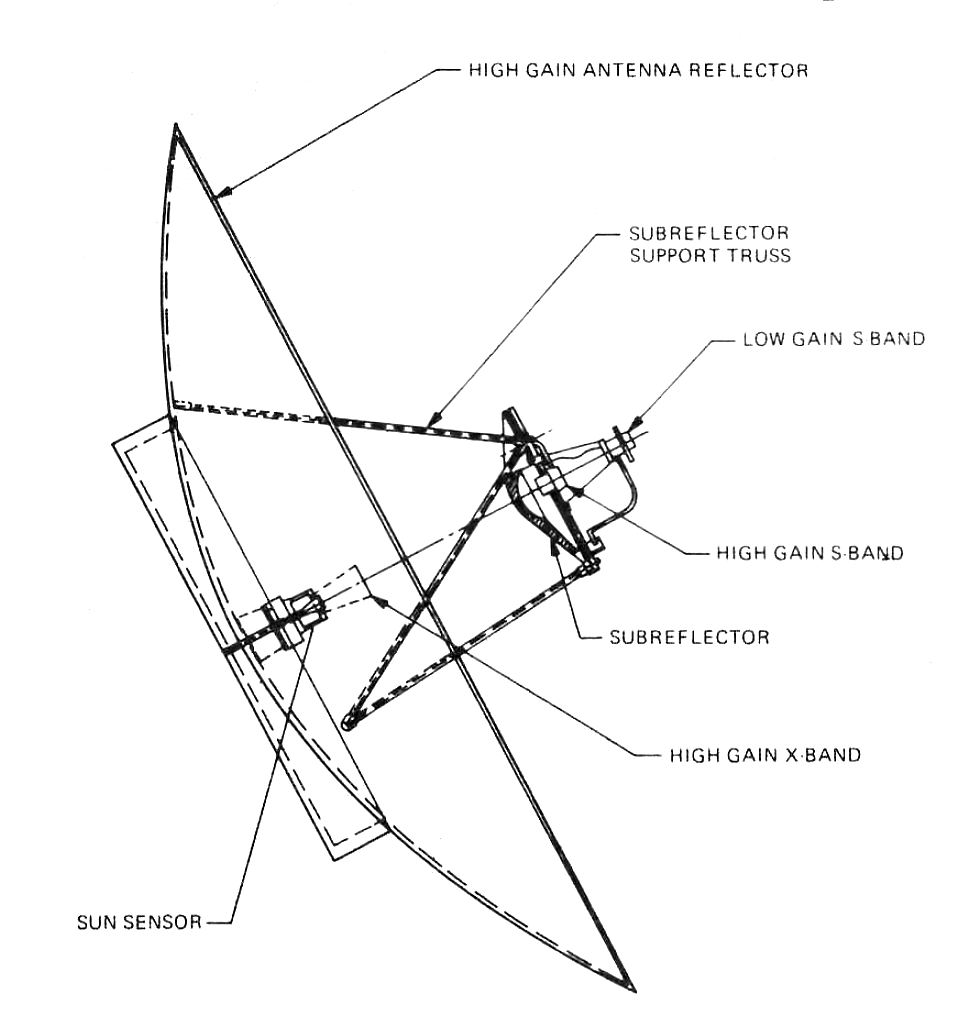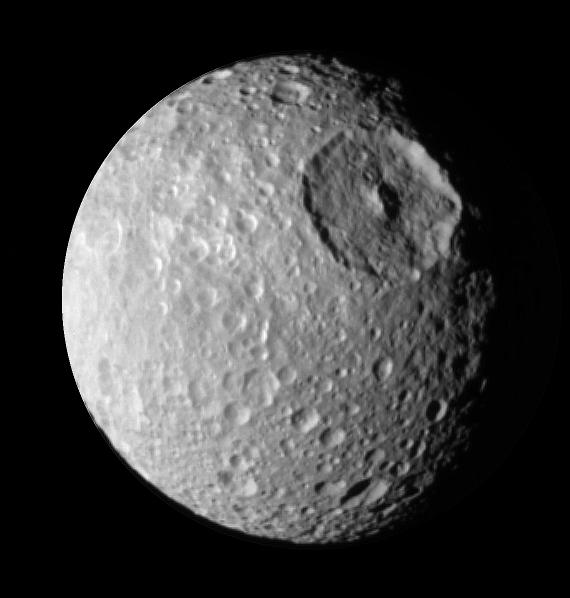|
Herschel (Mimantean Crater)
Herschel () is a large crater in the leading hemisphere of the Saturnian moon Mimas, centered on the equator at 112° longitude. It is named after the 18th-century astronomer William Herschel, who discovered Mimas in 1789. Size Herschel is the second-largest crater relative to its parent body of any equilibrium planetary moon in the Solar System after Tethys's crater Odysseus. It is so large that astronomers have expressed surprise that Mimas was not shattered by the impact that caused it. It measures across, almost one third the diameter of Mimas. Its walls are approximately high, parts of its floor are deep, and its central peak rises above the crater floor. If there were a crater of an equivalent scale on Earth Earth is the third planet from the Sun and the only astronomical object known to harbor life. While large volumes of water can be found throughout the Solar System, only Earth sustains liquid surface water. About 71% of Earth's surfa ... it would b ... [...More Info...] [...Related Items...] OR: [Wikipedia] [Google] [Baidu] |
Mimas (moon)
Mimas , also designated Saturn I, is a moon of Saturn discovered in 1789 by William Herschel. It is named after Mimas, a son of Gaia in Greek mythology. With a diameter of , it is the smallest astronomical body that is known to still be rounded in shape because of self-gravitation. However, Mimas is not actually in hydrostatic equilibrium for its current rotation. Discovery Mimas was discovered by the astronomer William Herschel on 17 September 1789. He recorded his discovery as follows: "I continued my observations constantly, whenever the weather would permit; and the great light of the forty-feet speculum was now of so much use, that I also, on the 17th of September, detected the seventh satellite, when it was at its greatest preceding elongation." The 40-foot telescope was a metal mirror reflecting telescope built by Herschel, with a aperture. The 40 feet refers to the length of the focus, not the aperture diameter as more common with modern telescopes. Name Mima ... [...More Info...] [...Related Items...] OR: [Wikipedia] [Google] [Baidu] |
Chasma
In planetary nomenclature, a chasma (''plural'': chasmata ) is a deep, elongated, steep-sided depression. As of 2020, the IAU has named 122 such features in the Solar System, on Venus (63), Mars (25), Saturn's satellites Mimas (6), Tethys (2), Dione (8) and Rhea (5), Uranus's satellites Ariel (7), Titania (2) and Oberon (1) and Pluto's satellite Charon (3). An example is Eos Chasma on Mars. Mars Below are images of some of the major chasmata of Mars. The map shows their relative locations. Interior layered deposits and sulfate Parts of the floor of Candor Chasma contains layered deposits that have been termed interior layered deposits (ILD's). These layers may have formed when the whole area was a giant lake. Some places on Mars contain hydrated sulfate deposits. Sulfate formation involves the presence of water. The European Space Agency's Mars Express found evidence of perhaps epsomite and kieserite. Scientists want to visit these areas with robotic rovers. Layers ... [...More Info...] [...Related Items...] OR: [Wikipedia] [Google] [Baidu] |
List Of Tallest Mountains In The Solar System
This is a list of the tallest mountains in the Solar System. This list includes peaks on all celestial bodies where significant mountains have been detected. For some celestial bodies, different peaks are given across different types of measurement. The solar system's tallest mountain is the central peak of Rheasilvia on the asteroid Vesta, estimated at up to 25 km from peak to base. Among the terrestrial planets the tallest mountain is Olympus Mons on Mars, at 21.9 km. __TOC__ List Heights are given from base to peak (although a precise definition for mean base level is lacking). Peak elevations above sea level are only available on Earth, and possibly Titan. On other worlds, peak elevations above an equipotential surface or a reference ellipsoid could be used if enough data is available for the calculation, but this is often not the case. Tallest mountains by elevation * Olympus Mons * Equatorial Ridge * Boösaule Mons * Ascraeus Mons * Ionian Mons * Elysium Mo ... [...More Info...] [...Related Items...] OR: [Wikipedia] [Google] [Baidu] |
List Of Largest Craters In The Solar System
Following are the largest impact craters on various worlds of the Solar System. For a full list of named craters, ''see List of craters in the Solar System''. See also * List of Solar System extremes ** List of largest lakes and seas in the Solar System ** List of largest rifts and valleys in the Solar System ** List of tallest mountains in the Solar System This is a list of the tallest mountains in the Solar System. This list includes peaks on all celestial bodies where significant mountains have been detected. For some celestial bodies, different peaks are given across different types of measure ... References {{Solar System table * Solar System Craters, largest in the Solar System Craters ... [...More Info...] [...Related Items...] OR: [Wikipedia] [Google] [Baidu] |
New Scientist
''New Scientist'' is a magazine covering all aspects of science and technology. Based in London, it publishes weekly English-language editions in the United Kingdom, the United States and Australia. An editorially separate organisation publishes a monthly Dutch-language edition. First published on 22 November 1956, ''New Scientist'' has been available in online form since 1996. Sold in retail outlets (paper edition) and on subscription (paper and/or online), the magazine covers news, features, reviews and commentary on science, technology and their implications. ''New Scientist'' also publishes speculative articles, ranging from the technical to the philosophical. ''New Scientist'' was acquired by Daily Mail and General Trust (DMGT) in March 2021. History Ownership The magazine was founded in 1956 by Tom Margerison, Max Raison and Nicholas Harrison as ''The New Scientist'', with Issue 1 on 22 November 1956, priced at one shilling (a twentieth of a pound in pre-decimal UK cu ... [...More Info...] [...Related Items...] OR: [Wikipedia] [Google] [Baidu] |
Voyager 1
''Voyager 1'' is a space probe launched by NASA on September 5, 1977, as part of the Voyager program to study the outer Solar System and interstellar space beyond the Sun's heliosphere. Launched 16 days after its twin ''Voyager 2'', ''Voyager 1'' has been operating for as of . It communicates through NASA's Deep Space Network to receive routine commands and to transmit data to Earth. Real-time distance and velocity data is provided by NASA and JPL. At a distance of from Earth , it is the most distant human-made object from Earth. The probe made flybys of Jupiter, Saturn, and Saturn's largest moon, Titan. NASA had a choice of either doing a Pluto or Titan flyby; exploration of the moon took priority because it was known to have a substantial atmosphere. ''Voyager 1'' studied the weather, magnetic fields, and rings of the two gas giants and was the first probe to provide detailed images of their moons. As part of the Voyager program and like its sister craft ''Voyager ... [...More Info...] [...Related Items...] OR: [Wikipedia] [Google] [Baidu] |
Space Science Institute
The Space Science Institute (SSI) in Boulder, Colorado, is a nonprofit, public-benefit corporation formed in 1992. Its purpose is to create and maintain an environment where scientific research and education programs can flourish in an integrated fashion. SSI is among the four non-profit institutes in the US cited in a 2007 report by Nature, including Southwest Research Institute, Planetary Science Institute, and Eureka Scientific, which manage federal grants for non-tenure-track astronomers. Description SSI's research program encompasses the following areas: space physics, earth science, planetary science, and astrophysics. The flight operations branch manages the Cassini-Huygens spacecraft's visible camera instrument and provides spectacular images of Saturn and its moons and rings to the public. SSI participates in mission operations and is home to the Cassini Imaging Central Laboratory for OPerations (CICLOPS). The primary goal of SSI is to bring togeth ... [...More Info...] [...Related Items...] OR: [Wikipedia] [Google] [Baidu] |
Star Wars (film)
''Star Wars'' (retroactively titled ''Star Wars: Episode IV – A New Hope'') is a 1977 American epic space opera film written and directed by George Lucas, produced by Lucasfilm and distributed by 20th Century Fox. It is the first film in the '' Star Wars'' film series and fourth chronological chapter of the " Skywalker Saga". Set "a long time ago" in a fictional universe where the galaxy is ruled by the tyrannical Galactic Empire, the story focuses on a group of freedom fighters known as the Rebel Alliance, who aim to destroy the Empire's newest weapon, the Death Star. Luke Skywalker becomes caught in the conflict while learning the ways of a metaphysical power known as "the Force" from Jedi Master Obi-Wan Kenobi. The cast includes Mark Hamill, Harrison Ford, Carrie Fisher, Peter Cushing, Alec Guinness, David Prowse, James Earl Jones, Anthony Daniels, Kenny Baker, and Peter Mayhew. Lucas had the idea for a science-fiction film in the vein of '' Flash Gordon'' aro ... [...More Info...] [...Related Items...] OR: [Wikipedia] [Google] [Baidu] |
Death Star
The Death Star is a fictional space station and Weapon of mass destruction, superweapon featured in the ''Star Wars'' Space opera, space-opera franchise. Constructed by the autocratic Galactic Empire (Star Wars), Galactic Empire, the Death Star is capable of annihilating entire planets into rubble, and serves to enforce the Empire's reign of terror. Appearing in the original 1977 film Star Wars (film), ''Star Wars'', the Death Star serves as a central plot point and setting for the movie, and is destroyed in an assault by the Rebel Alliance in the climax of the film. A larger Second Death Star is constructed in the events of the film ''Return of the Jedi'' featuring substantially improved capabilities compared to its predecessor, however it too is destroyed by the Rebel Alliance while under construction. Since its first appearance, the Death Star has become a cultural icon and a widely recognized element of the ''Star Wars'' franchise. It inspired numerous similar superweapons in ... [...More Info...] [...Related Items...] OR: [Wikipedia] [Google] [Baidu] |
NASA
The National Aeronautics and Space Administration (NASA ) is an independent agency of the US federal government responsible for the civil space program, aeronautics research, and space research. NASA was established in 1958, succeeding the National Advisory Committee for Aeronautics (NACA), to give the U.S. space development effort a distinctly civilian orientation, emphasizing peaceful applications in space science. NASA has since led most American space exploration, including Project Mercury, Project Gemini, the 1968-1972 Apollo Moon landing missions, the Skylab space station, and the Space Shuttle. NASA supports the International Space Station and oversees the development of the Orion spacecraft and the Space Launch System for the crewed lunar Artemis program, Commercial Crew spacecraft, and the planned Lunar Gateway space station. The agency is also responsible for the Launch Services Program, which provides oversight of launch operations and countdown management f ... [...More Info...] [...Related Items...] OR: [Wikipedia] [Google] [Baidu] |
Goddard Space Flight Center
The Goddard Space Flight Center (GSFC) is a major NASA space research laboratory located approximately northeast of Washington, D.C. in Greenbelt, Maryland, United States. Established on May 1, 1959 as NASA's first space flight center, GSFC employs approximately 10,000 civil servants and contractors. It is one of ten major NASA field centers, named in recognition of American rocket propulsion pioneer Robert H. Goddard. GSFC is partially within the former Goddard census-designated place; it has a Greenbelt mailing address.CENSUS 2000 BLOCK MAP: GODDARD CDP " . Retrieved on September 1, 2018. 1990 Census map of Prince ... [...More Info...] [...Related Items...] OR: [Wikipedia] [Google] [Baidu] |
Pac-Man (character)
is a fictional character and the titular protagonist of the video game franchise of the same name. Created by Toru Iwatani, he first appeared in the arcade game ''Pac-Man'' (1980), and has since appeared in more than 30 licensed sequels and spin-offs for multiple platforms, and spawning mass amounts of merchandise in his image, including two television series and a hit single by Buckner & Garcia. He is the official mascot of Bandai Namco Entertainment. Pac-Man's most common antagonists are the Ghost Gang — Blinky, Pinky, Inky and Clyde that are determined to defeat him to accomplish their goals, which change throughout the series. Pac-Man also has a voracious appetite, being able to consume vast amounts of food in a short timespan, and can eat his enemies by consuming large "Power Pellets". He also appears as a playable character in the '' Super Smash Bros.'' series. The idea of Pac-Man was taken from both the image of a pizza with a slice removed and from rounding out the Ja ... [...More Info...] [...Related Items...] OR: [Wikipedia] [Google] [Baidu] |

.png)



